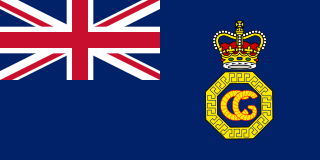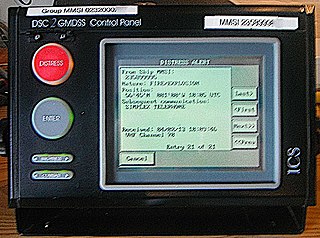Related Research Articles
Mayday is an emergency procedure word used internationally as a distress signal in voice-procedure radio communications.
Sécurité is a procedure word used in the maritime radio service that warns the crew that the following message is important safety information. The most common use of this is by coast radio stations before the broadcast of navigational warnings and meteorological information.

An emergency position-indicating radiobeacon (EPIRB) is a type of emergency locator beacon for commercial and recreational boats, a portable, battery-powered radio transmitter used in emergencies to locate boaters in distress and in need of immediate rescue. In the event of an emergency, such as a ship sinking or medical emergency onboard, the transmitter is activated and begins transmitting a continuous 406 MHz distress radio signal, which is used by search-and-rescue teams to quickly locate the emergency and render aid. The signal is detected by satellites operated by an international consortium of rescue services, COSPAS-SARSAT, which can detect emergency beacons anywhere on Earth transmitting on the distress frequency of 406 MHz. The satellites calculate the position or utilize the GPS coordinates of the beacon and quickly passes the information to the appropriate local first responder organization, which performs the search and rescue. As Search and Rescue approach the search areas, they use Direction Finding (DF) equipment to locate the beacon using the 121.5 MHz homing signal, or in newer EPIRBs, the AIS location signal. The basic purpose of this system is to help rescuers find survivors within the so-called "golden day" during which the majority of survivors can usually be saved. The feature distinguishing a modern EPIRB, often called GPIRB, from other types of emergency beacon is that it contains a GPS receiver and broadcasts its position, usually accurate within 100 m (330 ft), to facilitate location. Previous emergency beacons without a GPS can only be localized to within 2 km (1.2 mi) by the COSPAS satellites and relied heavily upon the 121.5 MHz homing signal to pin-point the beacons location as they arrived on scene.

SOS is a Morse code distress signal, used internationally, originally established for maritime use. In formal notation SOS is written with an overscore line, to indicate that the Morse code equivalents for the individual letters of "SOS" are transmitted as an unbroken sequence of three dots / three dashes / three dots, with no spaces between the letters. In International Morse Code three dots form the letter "S" and three dashes make the letter "O", so "S O S" became a common way to remember the order of the dots and dashes. IWB, VZE, 3B, and V7 form equivalent sequences, but traditionally SOS is the easiest to remember.
A distress signal, also known as a distress call, is an internationally recognized means for obtaining help. Distress signals are communicated by transmitting radio signals, displaying a visually observable item or illumination, or making a sound audible from a distance.

His Majesty's Coastguard (HMCG) is the section of the Maritime and Coastguard Agency responsible, through the Secretary of State for Transport to Parliament, for the initiation and co-ordination of all maritime search and rescue (SAR) within the UK Maritime Search and Rescue Region. This includes the mobilisation, organisation and tasking of adequate resources to respond to persons either in distress at sea, or to persons at risk of injury or death on the cliffs or shoreline of the United Kingdom. Since 2015 it has also been responsible for land-based search and rescue helicopter operations.

Marine VHF radio is a worldwide system of two way radio transceivers on ships and watercraft used for bidirectional voice communication from ship-to-ship, ship-to-shore, and in certain circumstances ship-to-aircraft. It uses FM channels in the very high frequency (VHF) radio band in the frequency range between 156 and 174 MHz, inclusive, designated by the International Telecommunication Union as the VHF maritime mobile band. In some countries additional channels are used, such as the L and F channels for leisure and fishing vessels in the Nordic countries. Transmitter power is limited to 25 watts, giving them a range of about 100 kilometres.
The Global Maritime Distress and Safety System (GMDSS) is a worldwide system for automated emergency signal communication for ships at sea developed by the United Nations' International Maritime Organization (IMO) as part of the SOLAS Convention.

Digital selective calling (DSC) is a standard for transmitting predefined digital messages via the medium-frequency (MF), high-frequency (HF) and very-high-frequency (VHF) maritime radio systems. It is a core part of the Global Maritime Distress Safety System (GMDSS).
Radiotelephony procedure includes various techniques used to clarify, simplify and standardize spoken communications over two-way radios, in use by the armed forces, in civil aviation, police and fire dispatching systems, citizens' band radio (CB), and amateur radio.
The aircraft emergency frequency is a frequency used on the aircraft band reserved for emergency communications for aircraft in distress. The frequencies are 121.5 MHz for civilian, also known as International Air Distress (IAD) or VHF Guard, and 243.0 MHz—the second harmonic of VHF guard—for military use, also known as Military Air Distress (MAD) or UHF Guard. Earlier emergency locator transmitters (ELTs) used the guard frequencies to transmit, but an additional frequency of 406 MHz is used by a more modern emergency locator transmitter.
In telecommunications, radio silence or Emissions Control (EMCON) is a status in which all fixed or mobile radio stations in an area are asked to stop transmitting for safety or security reasons.
A second mate or second officer (2/O) is a licensed member of the deck department of a merchant ship holding a Second Mates Certificate of Competence, by an authorised governing state of the International Maritime Organization (IMO). The second mate is the third in command and a watchkeeping officer, customarily the ship's navigator. Other duties vary, but the second mate is often the medical officer and in charge of maintaining distress signaling equipment. On oil tankers, the second mate usually assists the chief mate with the cargo operations.

The National Coastwatch Institution is a voluntary organisation and registered charity, providing a visual watch along the UK's coasts, and is not to be confused with HM Coastguard.

"Man overboard!" is an exclamation given aboard a vessel to indicate that a member of the crew or a passenger has fallen off of the ship into the water and is in need of immediate rescue. Whoever sees the person fall is to shout, "Man overboard!" and the call is then to be reported once by every crewman within earshot, even if they have not seen the victim fall, until everyone on deck has heard and given the same call. This ensures that all other crewmen have been alerted to the situation and notifies the officers of the need to act immediately to save the victim. Pointing continuously at the victim may aid the helmsman in approaching the victim.

2182 kHz is a radio frequency designed exclusively for distress calls and related calling operations in the maritime service.
Procedure words are words or phrases limited to radio telephone procedure used to facilitate communication by conveying information in a condensed standard verbal format. Prowords are voice versions of the much older procedural signs for Morse code which were first developed in the 1860s for Morse telegraphy, and their meaning is identical.
The Joint Rescue Coordination Centre Victoria (JRCC Victoria) is a rescue coordination centre operated by the 1 Canadian Air Division (Canadian Armed Forces) and staffed by personnel of the Royal Canadian Air Force (RCAF) and the Canadian Coast Guard (CCG).
An international distress frequency is a radio frequency that is designated for emergency communication by international agreement.
An emergency locator beacon is a radio beacon, a portable battery powered radio transmitter, used to locate airplanes, vessels, and persons in distress and in need of immediate rescue. Various types of emergency locator beacons are carried by aircraft, ships, vehicles, hikers and cross-country skiers. In case of an emergency, such as the aircraft crashing, the ship sinking, or a hiker becoming lost, the transmitter is deployed and begins to transmit a continuous radio signal, which is used by search and rescue teams to quickly find the emergency and render aid. The purpose of all emergency locator beacons is to help rescuers find survivors within the so-called "golden day", the first 24 hours following a traumatic event, during which the majority of survivors can usually be saved.
References
- 1 2 "Safety and Distress Radiotelephone Procedures". Transport Canada. 28 June 2013. Archived from the original on 5 August 2013. Retrieved 13 August 2013.
- ↑ District Eleven Response (dr). "Search and Rescue: Calling the Coast Guard". United States Coast Guard. Retrieved 13 August 2013.
- ↑ 1st Coast Guard District (6 September 2001). "Special Notice To Mariners" (PDF). United States Coast Guard. Retrieved 13 August 2013.
{{cite journal}}: Cite journal requires|journal=(help)CS1 maint: numeric names: authors list (link) - ↑ "RIC-22 – General Radiotelephone Operating Procedures". ic.gc.ca. Archived from the original on 2011-08-11.
- ↑ "RIC-22 – General Radiotelephone Operating Procedures". ic.gc.ca. Archived from the original on 2011-08-11.
- ↑ "International Radiotelegraph Convention of Washington, 1927" (PDF). search.itu.int. pp. 87–88. Retrieved 2021-01-09.
- ↑ Sara Hopkinson (14 November 2008). VHF Afloat. Fernhurst Books Limited. pp. 53–. ISBN 978-1-912177-41-7.
The origin of pan pan is from the French "en panne" meaning broken down.
- ↑ Popular Electronics. Ziff-Davis Publishing Company. 1974.
According to regulations, don't have an emergency unless you know the exact meaning of these three terms: Mayday, Pan and Security. They're of French origin and describe the exact degree of distress.
- ↑ Angus Stevenson; Maurice Waite (18 August 2011). Concise Oxford English Dictionary: Luxury Edition. OUP Oxford. pp. 1035–. ISBN 978-0-19-960111-0.
An international radio distress signal, of less urgency than a Mayday signal. Origin 1920s: pan from Fr. panne 'breakdown'.
- ↑ "Aviation Radio (AVI30316). Part 1 – Aircraft Radio Operation". ausacademy.org. Australian Unmanned Systems Academy (AUSA). Retrieved 3 May 2021.
PAN – As a Three-Letter Acronym (TLA): "Possible assistance needed" "Pay attention now". The TLA is derived from "pan" and is used in maritime and aeronautical radio communications courses as a mnemonic to radio and communications operators. Note: it is very important remember the difference between mayday and pan-pan emergency communications.
- ↑ Capt. David Moriarty (30 December 2014). Practical Human Factors for Pilots. Elsevier Science. pp. 168–. ISBN 978-0-12-800786-0.
- ↑ Mike Westin; Olle Landsell; Nina Olofsson (11 March 2021). Seamanship 2.0: Everything you need to know to get yourself out of trouble at sea. Bloomsbury Publishing. pp. 122–. ISBN 978-1-4729-7704-5.
- ↑ Transport Canada: "PAN PAN"
- ↑ "Air Traffic Organization Policy, Order JO7110.65W" (PDF). U.S. Department of Transportation, Federal Aviation Administration.
- 1 2 "Annex 10 to the Convention on International Civil Aviation: Aeronautical Telecommunications. Volume II: Communication Procedures including those with PANS status. Sixth Edition, October 2001" (PDF). ICAO. Retrieved 17 February 2023.
- 1 2 Lees, Graham; Williamson, William (4 July 2013). Handbook for Marine Radio Communication 5E. Taylor & Francis. p. 34. ISBN 978-1-134-46377-0 . Retrieved 17 February 2023.
- 1 2 Tim Bartlett (2009). VHF handbook. Southampton: The Royal Yachting Association. p. 53. ISBN 978-1-905104-03-1.
- ↑ Port, Andy Du (18 May 2021). Reeds VHF Handbook. Bloomsbury USA. p. 91. ISBN 978-1-4729-8144-8 . Retrieved 17 February 2023.
- ↑ "Marine Communications and Traffic Services". Government of Canada.
- ↑ "Non-GMDSS VHF Radiotelephone Procedures". webarchive.nationalarchives.gov.uk. Archived from the original on 2015-12-29. Retrieved 2019-09-14.
- 1 2 "When to Call Mayday Versus Pan-Pan – ATC Communication". Archived from the original on 8 October 2022. Retrieved 15 June 2022.
- ↑ https://www.raf.mod.uk/sites/raf-beta/assets/File/95E50AF2_D570_FF5F_478C01766B2F43C8(1).pdf
- ↑ "Distress and Diversion Cell: A Practical Guide to Practice Pan and Training Fix | Get into Flying". 26 July 2021.
- ↑ Radiotelephony Manual (CAP 413) https://publicapps.caa.co.uk/docs/33/CAP413%20E23%20A1%2026Nov2020.pdf